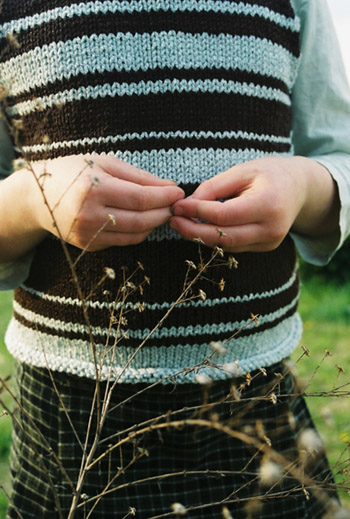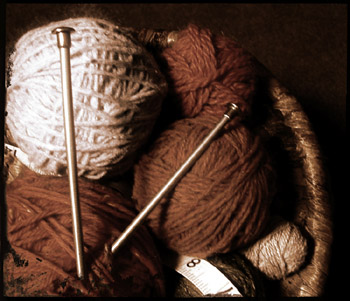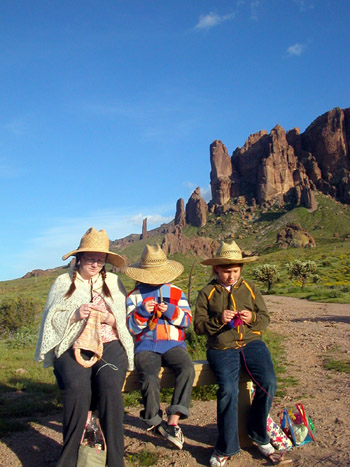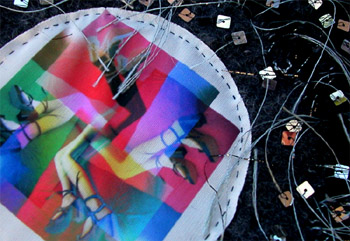
 Yikes.
There it is. An equation.
Just like the old days, when you were
squirming in your seat in math class.
Or maybe you loved figuring out formulas
and numerical sequences, and never
understood what the groaning coming
from the back row was all about.
Yikes.
There it is. An equation.
Just like the old days, when you were
squirming in your seat in math class.
Or maybe you loved figuring out formulas
and numerical sequences, and never
understood what the groaning coming
from the back row was all about.
I am a mathematician
by trade, but numbers mean much more
to me than just a job. Numbers, and
the way that they relate to one another,
are beautiful to me. They create order
and patterns, but they can also be
random and chaotic. I have always
been fascinated by how math is represented
in art, and I am perpetually seeking
ways to express my love for numbers
in my own artistic endeavors.
I fell in love
with knitting, the way many, many
people do. It may have been an unexpected
move in my life, but I have found
it to be the most direct way to incorporate
numbers into my art.
For my wife, knitting
was a way to pass the time and feel
productive after being diagnosed with
a debilitating disease. I saw how
quickly therapy turned to obsession,
but I didn't mind at all. In fact,
I loved it. After all, the kids and
I received many cool knitted objects:
hats, sweaters, wristbands, and even
socks.

 I
also may have been the only husband
for hundreds of miles who did not
mind spending the better part of every
weekend in knitting stores. Being
surrounded by all of that color and
texture was inspiring, and yarn has
always been one of my favorite photographic
subjects.
I
also may have been the only husband
for hundreds of miles who did not
mind spending the better part of every
weekend in knitting stores. Being
surrounded by all of that color and
texture was inspiring, and yarn has
always been one of my favorite photographic
subjects.
Our daughters have
been knitting since they were six
and eight years old. For them, using
sticks and string continues to be
a way to spend time with their mom,
as well as a form of relaxation, and
a source of constant and surprising
invention
After two and a
half years of watching and being the
official Hall Hartley yarn color selector,
I finally took up the needles as a
defense mechanism. I did not want
to become the ball winder by default.
My wife showed me the basics (she
says I was a know-it-all; it was a
short lesson) in December of 2004.
With the support of the three knitting
women in my family, and a quick purling
lesson from the seven-year-old, I
was on my way to knitting bliss.

 Now
knitting is a family affair, a way
to bond with each other and socialize
with other knitters. We have also
found that a shared interest makes
gift giving easy. Yarn is always the
perfect present for any occasion.
Now
knitting is a family affair, a way
to bond with each other and socialize
with other knitters. We have also
found that a shared interest makes
gift giving easy. Yarn is always the
perfect present for any occasion.
I had always appreciated
the possibilities of knitting as art,
but after learning to knit, the world
changed for me. I read through our
copy of Unexpected
Knitting by Debbie
New (Schoolhouse Press, 2003). This
book, and Debbie's work in general,
opened my eyes to just how much mathematics
can contribute to the art of knitting.
Although there are
patterns in the book, the author stresses
technique. Like Elizabeth Zimmermann,
Debbie New encourages knitters to
come up with their own answers to
knitting equations in order to create
something unique and meaningful.
With my background
in actuarial science and a job compiling
and reporting statistics for the health
insurance industry, people are often
surprised to hear that I am also a
fine art photographer. I hear many
comments about using both sides of
my brain. Of course, math is imperative
in photography, but I have found that
knitting is what truly brings my love
for both numbers and creativity into
one concentrated practice.

 I
often add photographic images to knitted
pieces, especially those that have
been felted into a more tightly woven
fabric. I print my photos on silk
and then stitch them to bags, vases,
accessories, and framed lengths of
knitted fabric.
I
often add photographic images to knitted
pieces, especially those that have
been felted into a more tightly woven
fabric. I print my photos on silk
and then stitch them to bags, vases,
accessories, and framed lengths of
knitted fabric.
Unexpected
Knitting may not be most knitters'
idea of a book for a beginner, but
Debbie New encourages knitters to
approach their work from a daring
standpoint. And daring runs in my
family. My nine-year-old, tired of
hearing, "Just one more row"
when she asked her mother to teach
her certain techniques, took matters
into her own hands. One Saturday morning,
when the rest of us were sleeping
in, she learned to turn cables, knit
Fair Isle, and make her own socks,
all from her
favorite book, Kids
Knitting by Melanie Falick
(Artisan, 1998). No one told her that
she couldn't, so the kid did it on
her own.
As a man writing
this article, I want to make something
clear. There is a view of gender inequality
regarding so-called natural mathematical
ability that is just not true. The
simple fact that so many women have
been, and continue to be, successful
and innovative knitters is proof that
math is part of every day life for
everyone, regardless of gender. I
am a knitter, an artist, a math nerd,
and a father. I feel it is important
to share this love of numbers, to
spread my view that math is not only
a necessary evil, but an integral
part of the natural world. As such,
we can all employ numbers in infinite
ways.
Nowhere is this
more true than in knitting. Even when
we follow a pattern exactly, we must
still measure, count, and make decisions
regarding size.
The Numbers
Bag is made of some of my favorite
numbers, ones that are important to
me. By doing this, I created a vessel
full of personal meaning.
Now it is time
for YOU to be bold as well. There
is nothing wrong with using the
pattern provided (after all, this
is a pattern resource). But you must
not be afraid to change things; either
completely or just a bit. If you decide
to use my pattern, substitute your
own numbers for mine (which are multiples
of eleven). See what shape your bag
(or vase, or hat) becomes.
It is such an easy
thing to just change the numbers.
By doing so, you are taking control
of math. You are using it for your
own expression, and that is a good
feeling.
If you are not
at the point in your knitting life
where you are ready for such a leap,
change something.
Use the pattern as a starting point,
a formula. Learn the techniques, and
then apply what you have learned to
make the pattern your own.
Start with a different yarn, throw
in some random (or carefully planned)
purls for texture. Change the gauge
by using different needles. Felt it.
Dye it. Embellish it with beads or
bottle caps or treasures mined from
the junk drawer. Make the piece truly
worth the effort. Make it yours. Enjoy
it.
There are so many
variables in knitting, and that is
what keeps knitters interested. Many
are related to basic math (size, proportion,
drape), and all are part of creating
art. Of course, there is color, the
first thing we usually notice. Then
there is contrast, texture, and even
negative space (think of an intricate
lace pattern). And, as in any art
form, the materials and tools you
employ make a difference, too. When
you look at it this way, you can turn
any pattern into a choose-your-own-adventure
project.
When we recognize
all of the aspects of knitting, we
are all on our way to becoming artists,
as well as mathematicians. And as
educated (and daring) knitters, we
can change any combination of variables,
or even just rearrange them a bit.
In doing so, we can use any idea or
pattern as a basic formula to create
a very personal work of art.
That is why
2
Needles + Yarn
Math
= Art

